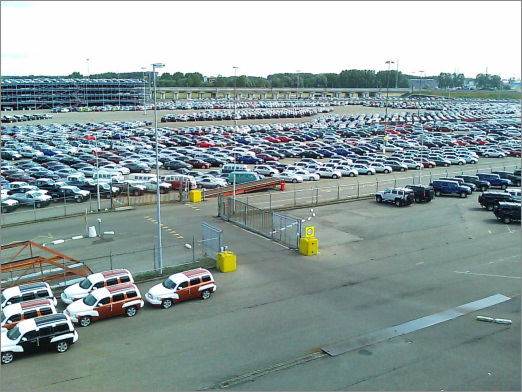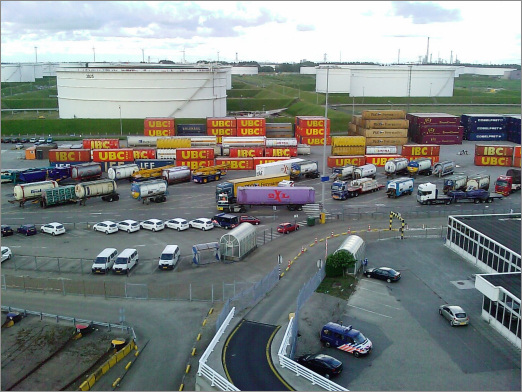| INFORMATION: Free information is available from Vehnet on the subject in this story. Click here to request a copy |
The yard is an important link in the supply chain, which, if overlooked, can impair supply chain visibility, service levels and response time, as well as impact on a companys bottom line. Steve Jones, Founder & Group Managing Director of Vehnet, suggests five ways that can result in immediate improvements to the management of your yard including the deployment of proven, specialised Yard Management software technology.
A lean supply chain is the ultimate objective of logistics professionals. Turning intellect, expertise and technology into visibility and control helps improve performance while reducing overall inventory and eliminating waste. However, whilst 3PLs and global integrators trumpet end-to-end supply chain visibility, the reality is that, in many cases, there is in fact a vital missing link in the chain, creating a costly blind spot at the operational level. That blind spot is in the last mile. It is where a logistics leg ends and consumption, storage, production or consolidation takes place. We are talking about The Yard.

If visibility is essential to managing a supply chain, then losing visibility of goods in the yard could be a serious problem. If eliminating wasted resources is important, then employing too much yard or dock labour is unacceptable. If payment of demurrage is a cost that eats into profitability, then clearly its time to take control of your yard.
Let's take some real-world examples. A global brand truck manufacturer operating a yard with an average of 400 trailers on site each day was paying over US$2 million annually for trailer demurrage until they implemented a specialist Yard Management System (YMS). That figure is now less than 50,000 dollars a year and falling. Another company, a major processing and distribution operation in the UK, found itself unable to plan its labour requirements effectively, due to shipments not being announced. After installing a sophisticated YMS with Appointment Scheduling the company reduced its yard labour costs by more than 20 per cent.
The largest importer/exporter and distributor of its kind in Europe, handling over 2000 inbound and outbound units a day, previously employed a team of people just to locate 'lost' units in their yard. Having implemented real-time locating RFID and integrating it with Yard Management software, its manpower requirement has reduced significantly because staff are now directed to the precise location in the optimal time and cost-saving sequence.
So, if you have yet to optimise your yard, take a closer look there are real benefits to be had. Here are five ways to make immediate improvements to the management of your yard, which will begin to close that unexploited supply chain gap.

1. Integrate - 'Tap your yard management into data flows'
Systems for procurement, production, warehousing and logistics are rich sources of data, and while the systems will often be from different vendors, or in-house developed, they are frequently integrated. Tip #1 is 'Tap your yard management into these data flows'. This will translate to immediate benefits. By capturing SKU details from supplier ASNs and recording the trailer ID in which the ASN arrives, then visibility and the ability to optimise trailer parking and dock sequencing jump an order of magnitude. For example, in a factory scenario, material planners can call for a part and be confident that the tug driver will place it at the correct dock door, or better, upon arrival the truck driver can either be directed to the dock door or a nearby parking slot, so reducing the demand on own labour.
2. Specialise - 'Look for proven, specialist yard management software.
While some WMS and TMS offer a yard solution, experience shows this will often be a module of minor importance, poor in specialised functionality. Some yard management software is aimed at replacing clipboards and paper, whilst other offerings are in reality promoting a particular brand of RFID or locating technology, so that the optimum solution for your yard may be overlooked. On the other hand, in-house solutions may well require substantial investment to deliver up-to-date technology. Tip #2 therefore is: 'Look for yard management software which is proven, flexible, independent of hardware from a specialist with a track record'.
3. Design Poor design leads to inefficient operation and higher costs
Poor yard layout costs companies a great deal of money because of inefficient operation. Proven and specialist YMS solutions will use true-scale drawing tools with active objects which can represent roadway directions, speeds, dock capacities and so on and will take account of factors such as material flows, dock assignments and production patterns. These factors act as 'magnets' to the incoming trailers, containers and other carriers. Such tools will permit alternative layouts to handle variability or seasonality. True-scale design has impact on safety and security too. Tip #3 is therefore: 'Look hard at your yard layout and measure the results as you implement the changes'.
4. Optimise - 'Look for opportunities to optimise yard decisions automatically'.
Any yard is full of opportunities to optimise operations and because there are hundreds of operations each day, and many thousands each year, even modest optimisation will result in significant bottom line improvements. When implementing yard management software, an early step is to identify scenarios suitable for optimisation. Specialised Yard Management software technology will constantly evaluate operations and will, for example, propose the best slot for a trailer to be parked, the best dock, the next empty trailer to be picked up by an entering carrier, trailers coming close to incurring demurrage charges, over-capacity dock and yard labour etc. Paying attention to these sources of wasted time and money pays big results because they are played out thousands of times a year. Optimisation is about capturing the know-how of your yard professionals and making it integral to the yard management solution, freeing up time for managers and supervisors to handle the true exceptions. Therefore Tip #4 is 'Look for opportunities to optimise yard decisions automatically'.
5. Analyse - 'Demand detailed analysis reports
Professionals want to know how well they performed and whether/how they might improve in the future. Data captured in real-time during operations is therefore invaluable for analysis, re-play and learning. To raise the bar on analysis, we support peer group benchmarking that takes subscribers blinded data and allows access to overall performance figures, with the option to see your own ranking in a confidential report. Areas for potential improvement are monetised in a practical action list. Multi-site organisations that use benchmarking quickly spot opportunities for improvement. They are able to roll out best practice so multiplying the benefits across all locations. Tip #5 therefore is 'Demand detailed analysis reports from your yard management software provider, and question whether your TMS can support peer group benchmarking
Conclusion
Without doubt, the yard is an important link in the supply chain, which, if overlooked, will impair supply chain visibility, service levels and response time not to mention impact on your bottom line. Simple yard management as bundled with WMS and TMS or offered as stand-alone solutions can provide some solutions to this challenge, but more specialised systems, which can tap into multiple data flows from WMS and TMS will deliver tangible, better quality and more holistic results. Systems which can also pro-actively optimise operations taking account of business priorities, resource constraints and spatial geometry should be reviewed by serious operators as these are the future for closing the missing link and achieving the lean and agile supply chain to which we all aspire.
| INFORMATION: Free information is available from Vehnet on the subject in this story. Click here to request a copy |

Add a Comment
No messages on this article yet